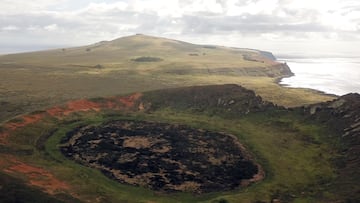Historic discovery on Easter Island
A major drought and wildfire has revealed a moai statue different from all those on Easter Island inside the crater of the Rano Raraku volcano.

Much of the blame for Easter Island’s enigma surrounding its culture and past lies with the Rano Raraku volcano. Now, for the first time since time immemorial, the lack of rain caused by the climate crisis and a raging fire that has swept away the cat-tail reeds of the freshwater lagoon located in the Inside the crater, allowing a very peculiar moai to be seen.
It is an ancient sculpture five feet tall and three feet wide, which was not only completely unknown to the Rapanui community that inhabits the island, but is also very different from the other anthropomorphic statues already discovered. Other objects and stone fragments have even been found that could be part of another moai. All of this was discovered on 20 February by a team of scientific volunteers from various universities who were studying the consequences of the fire that devastated 100 hectares of the island last October.
This is a very special find.
In statements to El País, the vice president of the Ma’u Henua indigenous community -in charge of the Rapa Nui National Park-, Salvador Atan Hito, assured: “We never thought we could encounter these archaeological finds in this place”. And it is that the volcano, whose age is around 300,000 years, is the quarry that was used by the Rapanui ancestors to build the almost 900 statues -of volcanic stone toba lapilli- that silently watch over the island.
This discovery is particularly revealing due to the characteristics of the statue. While the average height of a moai is between 33 and 39 feet tall, the newest discovered moai is much smaller. Atan Hito himself has pointed out that due to its “contexture and shape” it most likely belongs to the branch of the Hoa Hakananai’a, the moai exhibited in the British Museum.
What is the future of the new moai?
As with all archaeological finds, the statue’s future is a dilemma. The debate is similar to that always raised by historical remains: not alter it so as not to harm the will of the ancestors or lend it to scientific research. The mayor of Rapa Nui, Pedro Edmunds, is a firm supporter of the former and leaves the last word to the Rapanui families and the council of elders, since he considers that it is they who have the power to decide how to defend their culture next to the park administration; And it is right here, in the community in charge of managing the place, where Atan Hito is located, a supporter of greater scientific research that is the responsibility of everyone since the island is a World Heritage Site. The future of the moai, for now, is not beyond the Rapanui coast.






